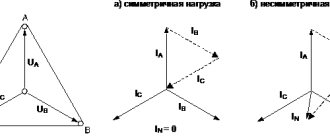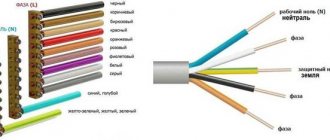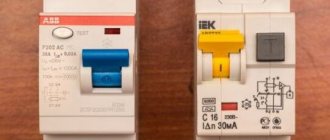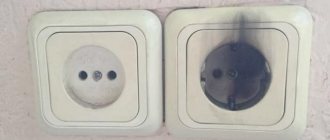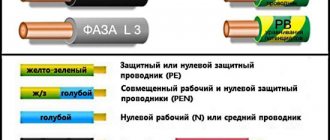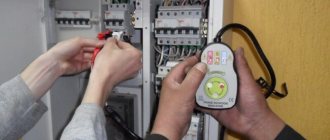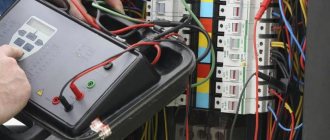Everyone knows that current in an electrical network flows in a closed circuit, powering a variety of household appliances and industrial equipment. The network for supplying electricity to private houses, apartments and cottages is one of the areas of electricity distribution in the global energy supply system for various objects. All this suggests that to power household electrical appliances, at least two electrical conductors are needed, which will create a closed circuit for powering home appliances.
These conductors are called phase (L) and working neutral (N). “Zero” is not dangerous for a person when touching it, since there is no mains voltage on it. But this does not mean that electric current does not flow through it. Ideally, in a single-phase network, the amount of current passing through the phase conductor completely coincides with the value of this parameter flowing through the neutral wire. In this article we will look at the question of the causes of breaks or burns of the neutral conductor, what happens in the event of such an emergency, the consequences of this accident, and what protection against the break of the “zero” can eliminate such a negative phenomenon.
Attention! Burning of the neutral conductor in a three-phase main power supply line can cause a change in the voltage value from a minimum to a maximum value of 380 V, and a break in the “zero” of the internal electrical wiring will de-energize the network with the appearance of a phase at the zero contact of the socket.
How to ground electrical equipment
Next, we will talk about where the protective grounding comes from into our house, and consider its path from the transformer substation and whether it is safe to carry out grounding in the apartment. Such grounding begins with a solidly grounded neutral - connected to the grounding device of the neutral of the power transformer.
The neutral, together with the three-phase line, first enters the input cabinet. From there it is distributed to the electrical panels located on the floors.
The working zero is taken from it, which together with the phase forms the phase voltage that is familiar to us. The name “working zero” is due to the fact that it is used to operate electrical installations or electrical appliances.
A separate protective zero taken from the electrical panel, which has an electrical connection with a solidly grounded neutral, forms a protective zero. It is imperative to know that there should be no switching devices (automatic machines, switches, etc.) or fuses in the circuit of protective grounding conductors.
Zero burnout: accident or inevitability
You can deal with electricity problems correctly if you become familiar with zero burnout. If you have heard from your friends the phrase that electrical appliances and expensive equipment burned out in the apartment due to a voltage drop, this means that their power supply is not 220V, but 380V. Where does the 380 Volt voltage in the electrical network come from? Often, this is due to a break in the zero, or, as is customary in the vocabulary of electricians, burnout of the zero. Why does the zero burn out? To understand this, let’s consider in general terms what an electrical network is. An electrical network is a set of electrical installations through which electricity is transmitted and distributed from the power plant to the end consumer.
Let's sum it up
Of course, the probabilities of accidents are random; the most that can be done in such situations is to take the necessary measures to ensure protection. But besides this, it would not be superfluous to identify an emergency situation in time based on its characteristic signs. First of all, the burning out of the neutral main wire leads to network overvoltage. Having discovered the first signs of this phenomenon, you should turn off all electrical appliances.
Doing this quickly and independently is almost impossible. The time period for this is too short, so you should install special devices on the electrical panel that respond to a zero break. As soon as the voltage goes beyond the set limits, the voltage control relay will perform a protective shutdown.
You should not completely trust the security system. It may happen that if there are characteristic signs of voltage surges, a power outage will not occur. Therefore, it makes sense to list the most likely manifestations for this phenomenon:
- Flickering of incandescent lamps. They are most sensitive to the difference in voltage level that occurs when the zero is broken. Energy-efficient lighting fixtures and LED lamps are not as responsive to changes.
- Electronic devices that have built-in protection are usually disconnected from the power supply. Or they don't start. Such actions are provided for by the protection response of pulsed power supply units to voltage surges. It is typical that such a reaction can operate earlier than the voltage relay. But this largely depends on the manufacturer and the implementation scheme for protecting electrical networks, as well as the reliability of the electrical connection.
- Another characteristic sign is an increase in the temperature of the switch. Even if you did not pay attention to the flickering of the lamps, this manifestation should cause concern.
- Sparking when trying to connect an electrical appliance may indicate a zero break at the input of a single-phase consumer. Even if it is caused by another factor, and not a zero break, this is a very bad sign.
- Spontaneous operation of input circuit breakers may also indicate overvoltage. This reaction to a zero break is typical when turning on electric heating devices, such as an electric furnace, boiler, kettle, etc.
- Characteristic sounds in the input electrical panel may also indicate voltage drops. In such a situation, it is recommended to turn off the power input and wait for the emergency team to arrive. There is a high probability that a zero-loss accident occurred in the supplier’s power grid.
- Be sure to install a voltage relay at the electrical input. Ideally, it is advisable to duplicate this system with a voltage stabilizer for a house or apartment. Such a device, working in tandem with a relay, will allow you to maintain a given voltage level without turning off the power.
In fact, only multi-level protection can provide maximum security.
What does zero burnout lead to in a three-phase network?
What will change if the neutral wire N breaks BEFORE the junction of the neutral wires at one point? There will be a zero break in a three-phase network:
Zero break in a three-phase network
If you look at the diagram, to the right of the break point the voltage will now not be zero, but “walk” within arbitrary limits.
What happens if the zero is disconnected (accidentally or intentionally)? What voltages will be supplied to consumers instead of 220V? It depends.
The picture in a different form may be easier to understand:
Phase imbalance as a result of zero loss.
Consumers are conventionally shown as resistances R1, R2, R3. The voltages shown in the previous figure are as
220B, designated as
0…380V. I'll explain why.
So, what happens if the zero disappears (the cross in the lower right corner)? In an ideal case, when the electrical resistance of all consumers is the same, nothing will change at all. That is, there will be no phase imbalance. This happens when three-phase consumers are turned on, for example, electric motors or powerful air heaters.
But in real life this never happens. There is no one in one apartment, and only the TV is on in standby mode and the phone is charging. And the neighbors on the site did the laundry, turned on the split system and electric kettle. And then - BANG! - the zero burns out.
Phase imbalance begins. And how brutal it is depends on the real situation.
For neighbors who are at home, the kettle will stop heating, the washing machine and splitter will go out, and the voltage will drop to 50...100V. Because the “resistance” of these neighbors is much lower than that of those who are not at home. And so, these people are quietly working at work, and at this time in their empty apartment their TV and Chinese charger are smoking. Because the voltage in the sockets jumped to 300...350V.
These are real facts and figures, this sometimes happens, the condition of electrical panels on staircases is often disastrous. Even when a major renovation is carried out in the house, the panels are not touched, since changing the electrical system is much more difficult than painting the house and installing new windows.
Such a fire should be investigated not by calling psychics (you never know, a poltergeist is playing with matches;)), but by calling an electrician.
Why is zeroing in an apartment dangerous?
Grounding is significantly different from grounding. Let's try to look at this difference in more detail. In accordance with the PUE, the use of such deliberate protection as zeroing at the household level is prohibited due to its unsafety.
But, despite the fact that such a system should only be practiced in industrial production, many people install it in their apartments. They resort to this less-than-perfect defense, in particular, due to the lack of another option or due to a lack of knowledge in this area.
Indeed, it is possible to do zeroing in an apartment, but the consequences of this will be far from the best. Next, using examples, we will consider some situations that may arise if grounding is performed in an apartment.
1) Grounding in sockets
Sometimes it is proposed to “ground” electrical appliances by jumping the working zero terminal in the socket to a protective contact. This method of “grounding” does not comply with the requirements of clause 1.7.132 of the PUE, because it implies the use of the neutral conductor of a two-wire network as a protective and working zero at the same time.
In addition, at the entrance to the apartment there is usually a device designed for switching both phase and zero, for example, a packager or a two-pole device. But it is prohibited to switch the neutral conductor, which is used as a protective conductor. That is, a conductor whose circuit has a switching device cannot be used as a protective conductor.
The danger of “grounding” with a jumper in a socket is that the housings of electrical appliances, if the integrity of the zero is broken anywhere, will be under phase voltage. If the neutral wire breaks, the operation of the electrical receiver is interrupted, and then such a wire appears de-energized, that is, safe, which, of course, aggravates the situation.
One can only imagine how much trouble such an outlet would cause if a washing machine was plugged into it. In this case, you can see a jumper that connects the “zero” contact to the protective one. And if the “zero” burned out, then such a washing machine would turn into a “killer”.
If, while a person is taking a shower, zero “snot” falls out in the socket to which the boiler is connected, such a person will simply be electrocuted. Therefore, such grounding in an apartment is extremely dangerous and is prohibited.
2) Phase and zero are reversed
By looking at the following example, you can clearly see the most likely danger in a two-wire riser. Often, when carrying out any repair work in household electrical equipment, zero “N” is mistakenly swapped with phase “L”.
The cores of the wires in the electrical panel in houses with two-wire wiring do not have a distinctive color, and when performing any work in the panel, any electrician can switch the zero and phase in places - the housings of electrical appliances in this case will also be under phase voltage.
It is imperative to remember the high danger of performing protective grounding in a two-wire system. Therefore, according to the rules, this is prohibited!
3) Zero burnout
Every electrician knows what “zero burnout” or zero break is, but not every electricity consumer knows. Let's try to understand the meaning of this phrase and find out what is the danger of zero burning?
Very often, a break in the “zero” is fixed in houses with old wiring, the basis for the design of which was the calculation of approximately 2 kW per apartment. Of course, the current equipment of apartments with all kinds of electrical appliances increases these figures by an order of magnitude.
In the event of a “zero” break, a phase imbalance can occur at the transformer substation from which a multi-storey building is powered, in a common electrical panel or in a panel on the landing of this house, in a power line located after this break. The result may be that one part of the apartments receives low voltage, and another part receives high voltage.
Low voltage is dangerous for refrigerators, air conditioners, split systems, hoods, fans and other equipment with electric motors. As for the increased voltage, any household appliance can fail.
Similar materials on the site:
- Earthing sign sticker
- How to calculate a ground loop
- Ground loop diagram
Methods of protection against zero break
To reduce the potential on the neutral conductor and, accordingly, to increase the effective difference between the standard phase voltage of the network and the zero, multiple re-grounding of the combined zero is used. This measure is also intended to reduce the negative consequences for consumers due to a break in the neutral conductor in the power supply network.
The arrow indicates the re-grounding of the zero (PEN) on the overhead line support
Unfortunately, in many provincial regions, especially in rural areas, the re-grounding resistance is insufficient to provide reliable protection against overvoltage that occurs when the neutral wire breaks. In addition, on overhead lines of the power supply network, which predominate in rural areas, zero breaks occur much more often than in urban underground or hidden (protected) power lines.
An ordinary consumer can influence the quality of the power supply at the input only with the help of legal instruments - complaints, petitions, lawsuits, etc. But in a home network, it is possible to maintain an acceptable level of power quality with the help of stabilizers. And you can protect yourself in emergency situations by using voltage relays or automatic devices with additional functions.
Joule-Lenz law
Toki Fuko. Eddy currents and their applications
Features of home electrical wiring protection
Organizing protection against emerging high voltage is one of the key issues when laying an electrical network in a residential building. It is carried out using special transformers and network filters. In many houses, automatic switches are installed on the floor panels, which protect against electric currents during short circuits and temporary overloads.
When high loads are possible, all devices that protect networks from overvoltage must have automatic shutdown devices and switches that respond to changes in current levels. As a rule, the most reliable protection against such surges is placed on the input power wire, since it is this that experiences the greatest impact during load peaks.
The surge protection circuit for a home electrical network can be simple or multi-level. Simple - represented mainly by overvoltage relays in floor panels, and multi-stage (combined, protecting both from household power surges and from pulsed ones during thunderstorms) - SPD, i.e. Surge protection devices. Such devices are most often found in private homes.
Note! Electronic devices fail due to both increased and decreased voltage in the network (for example, refrigerators are difficult to start, which negatively affects their further operation). The insulating layers of home electrical networks are designed, as a rule, for standard 220V, therefore, if the voltage increases many times, a spark jumps in the dielectric layer, which can provoke an electric arc and further fire
The insulating layers of home electrical networks are designed, as a rule, for standard 220V, therefore, if the voltage increases many times, a spark jumps in the dielectric layer, which can provoke an electric arc and further fire.
To prevent negative consequences, the following protections are used, operating according to the following principles:
- when there is a sharp unscheduled increase in voltage, the electrical circuit in the house or apartment is disconnected;
- outputting the received excess electrical potential from electrical appliances by transferring it to an earth circuit.
If the voltage rises slightly (for example, up to 380 volts), various stabilizers come to the rescue. However, their protective capabilities are quite limited - they are more designed to maintain specified operating values in electrical networks.
When designing protection for a private home, various design solutions and their technical characteristics are considered. It is necessary to take into account the principles of forming a base of surge limiters (SPS). For example, gas-filled arresters, after the pulse has passed, pass through the so-called. accompanying current, the voltage of which is comparable to a short circuit. For this reason, they themselves can be a source of ignition, and they cannot be used for protection against electrical breakdown.
For home networks, varistor protection devices (semiconductor resistors) are most often used - rheostats composed of varistor “tablets” made from a mixture of oxides of zinc, bismuth, cobalt and others. During normal operation of the electrical network, such a circuit breaker allows microscopic leaks, and when a pulse of high voltage passes through, it is capable of instantly switching to the “tunnel” mode and “draining” more than a thousand amperes in a very short period of time, since the resistance on this device decreases with increasing current strength, after which there is a quick return to normal “combat readiness”.
Zero break in a single-phase network
Here the picture will be as follows:
Zero break in a single-phase network
For a load that operates on other phases, nothing will change at all. It’s the same as if you turn off the automatic circuit breakers in your apartment – your neighbors won’t give a damn.
But if a break occurs, for example, in a panel, then the entire apartment, including the broken end of the neutral wire, will be under 220V voltage!
Breakage (burnout) happens because of rusty bolts like those at the top of this photo:
Bad zero. Missing zero in the apartment
I repeat - if the grounding is done correctly, or if there is no grounding at all, this accident is not dangerous in any way. And, of course, you don’t need to touch the wires without waiting for an electrician - they all have deadly potential!
Okay, we understand who is to blame. What to do?
Why is the phenomenon dangerous?
The overvoltage in the electrical network looks like this:
The insulation of electrical cables and wires, as well as any electrical appliances, can withstand only a certain voltage level specified in the operating documents for them. Below is a table that shows the approximate values of the electrical insulation strength of electrical wiring and electrical equipment.
However, in household electrical equipment the main thing is not this (the insulation cannot be replaced), but insulation failures caused by mechanical reasons (including as a result of fastening electrical wiring with squeezing and twisting), climatic (dampness, water ingress) and purely economic (accumulation of dust, dirt , insects, etc.). So, on top of all these violations there are also overvoltages.
All this leads, as sad cases show, to the failure of electrical wiring and electrical appliances, and to tragic fires. If the electrical protection in the house is also broken (faulty or rough due to frequent activation), then the likelihood of fires as a result of electrical overload or short circuit increases sharply. While a damaged electrical appliance can be simply unplugged from the outlet and replaced with a working one, the electrical wiring cannot be quickly replaced. The photo shows insulation failure in an outlet, which is often caused by loose connections and overheating, or by a lightning event that can overload the wiring and cause a short circuit.
Thus, overvoltages in the home electrical network are especially dangerous for old electrical wiring that is not subject to preventive inspection (along with sockets) and is not updated, where sockets are handled carelessly, allowing them to overheat. In this regard, old electrical wiring in houses that are often exposed to thunderstorms and insect infestations (villages and towns) should be considered especially dangerous in this regard.
Consequences of a zero break in a three-phase network
I'll tell you stories from my life.
- Electricians were repairing the entrance to the entrance. And during the repair, the working zero was turned off for a few seconds. A very unpleasant thing happened: when people returned home in the evening, they discovered that their TVs, refrigerators, chargers, etc. had burned out. - something that is constantly plugged into our outlets. It's good that there hasn't been a fire yet.
- Came on call, complained - tension was floating. I measure the voltage (everything is turned off) - almost 300 volts. Then, when the incandescent lamp is turned on, the voltage drops to 70V... It turned out that a bolt had burnt out in the floor panel, which received a zero. There was a break in the zero, a phase imbalance, and voltages went wild. I replaced the bolt, restored contact, and the voltage returned to normal.
Scratch bolt. Rusty, does not leak periodically. If you change it without turning it off, 100% of the equipment in the entrance will burn out!
An article on how I changed the electrical panel there is here.
I was called to an advertising and publishing company. According to preliminary estimates, the damage is more than 100 thousand rubles, and all due to poor contact on the zero bus:
Zero burnout from the zero bus
The neutral wire burned off from the second bolt. You can see how it fell off under tension. Before falling off, it ALMOST melted the insulation of the phase wires (vertical, red and white).
The server has not been turned on yet, perhaps the intellectual damage will be greater...
As you can see, such problems occur due to incorrect actions of “electricians” or due to spontaneous breakage (burnout) of the neutral wire in the old housing stock.
In this article I will tell you in detail why this happens and how to deal with it.
Causes of zero break
There are quite a few reasons - a break in the neutral at the substation, in house and access panels, inexperience of electricians, lack of maintenance of electrical networks, and so on. The main reason for neutral breakage is poor-quality wire fastening.
If the neutral is weakly fastened, the wire heats up, oxidizes (which increases the resistance of the neutral-to-housing transition) and burns out. It is also possible for the neutral to burn out when using large fuse ratings.
The neutral often breaks due to strong gusts of wind, icing, repair work, etc. As you can see, there are many reasons for the neutral to break. To avoid the consequences of this malfunction, you need to choose the right protection option.
Causes and consequences of zero loss
People encountered the concept of zero loss relatively recently - in the 90s. Then a huge amount of modern household appliances and equipment appeared on the market, differing from the classical ones in that when such devices with different resistance values were turned on, additional pulse currents were released into the electrical network, which were not compensated at the midpoint. This led to the accumulation of a current exceeding or equal to one of the phases on the neutral conductor, which contributed to the overload of the neutral wire.
The zero burns out mainly in a poorly crimped contact - the so-called weak point.
A zero break can occur if the house has old wiring
The main reasons for zero loss:
- Voltage surge or short circuit;
- Poor quality of wire connections or weak contact;
- Natural damage to power lines;
- Negligence during repair work;
- Old wiring, which, in addition, gets very hot under modern loads.
To determine the location of the damaged conductor, you can use a special tester, with which you can determine the exact position of the break even under a layer of plaster, or use the method of visual inspection of the switchboard in the apartment. Perhaps the reason lies there and is easily eliminated. If a zero break occurs outside the area of your apartment, you should not show initiative and fix the problem yourself. You should immediately contact the appropriate services, which will quickly, competently and without consequences eliminate the cause and protect residents from undesirable consequences.
Acceptable electricity parameters
The voltage rating indicated on all household electrical appliances is 220V, but in real life this value is not always stable. This is taken into account in the manufacture of modern devices, and they can operate stably with voltage fluctuations from 209 to 231V, as well as withstand a spread from 198 to 242V. If small differences in potential differences were not provided for by the design of household appliances, they would break down constantly. More significant deviations lead to network overload, and this reduces the operational life of the equipment.
To smooth out voltage fluctuations and ensure the safety of devices, it is enough to install a stabilizer. Overvoltage (the so-called sharp jump in potential difference) is much more dangerous for electrical engineering.
Break of the neutral wire in three-phase and single-phase networks
As you know, electric current flows through a closed circuit, doing work. The home electrical network is one of many branches of the global energy supply network. This means that for the operation of household electrical appliances, it is necessary that at least two conductors be connected through which current will flow.
For rational reasons described below, they are called phase and neutral working wires (N). This article explains the function of the working neutral conductor, and describes the problems that arise if an emergency zero break occurs.
Almost all adults know that the neutral conductor of the network, operating in normal mode, does not pose a threat when touched, since there is no voltage on it that is hazardous to health. But this does not mean that no current flows through the zero wire - you need to clearly distinguish between these concepts. In an ideal circuit, the current of the phase and neutral conductors is identical.
Where does the 380V outlet come from when the zero is broken - clearly, accessible, without formulas.
Surely each of you has had household appliances burn out due to overvoltage at least once in your life. At the same time, many have heard that this often happens due to a zero break.
Let's visually, without formulas, vector diagrams, zero point offsets, etc., from the point of view of the average person, try to figure out how the voltage of 380V, instead of the usual 220V, can end up in your sockets.
After all, a logical question really arises: how is it that one of the wires has broken or burned out, but the voltage does not disappear, but becomes even greater.
Understanding this process will be useful to every consumer, so that later there will be no questions about why electricians are trying to “stick” incomprehensible relays costing several thousand rubles into the electrical panel.
To clearly understand the essence of this phenomenon, let's remember the difference between the serial and parallel circuit for connecting electrical receivers.
With a parallel connection, the phase and neutral conductors simultaneously reach all consumers in the circuit. Let's draw a diagram where these consumers are ordinary incandescent light bulbs.
The input voltage is 220V. With this connection, the voltage on each light bulb will be the same, and with a sufficient cross-section of conductors and a low load, it will not differ much from the input one.
In this case, turning off or turning on each light bulb in turn will not greatly affect its values. It is according to this scheme that all sockets in your apartments are connected.
However, if the voltage is the same, the current in the circuit will be different. Its total value is the sum of the currents passing through bulb No. 1 and No. 2.
You can turn on more powerful devices (200W lamps, kettle), and everything will work perfectly.
The serial connection scheme already introduces significant changes. Here the supply conductor (this can be phase or zero) first comes to the first light bulb, and then leaves it to the next one.
Only after this does it return to the input machine or to the general network.
The number of pantographs does not matter, there can be 2,3,4 or more. The main thing is that they are strictly connected one after the other
What will change if you turn on two 100W lamps in series? What will happen is that the voltage on them will drop by about half.
In this case, the total input voltage will be the sum of the voltage drops across lamp No. 1 and lamp No. 2. That is, 110v on one and 110v on the other. By the way, this seemingly disadvantage can be used very cleverly in several ways.
Let me remind you that in a parallel circuit, U was the same everywhere, no matter at what point. Here the current will be the same, while in any part of the electrical circuit I=I1=I2
However, such a situation with a uniform voltage drop will only be observed if all electrical receivers are of the same power. Instead of one 100W lamp, just screw in a 200-watt one, and you will immediately see the difference.
A 100W bulb will have a voltage of 146V and will burn quite brightly. At the same time, a more powerful 200 watt one will barely glow.
This is due to the fact that the voltage drop directly depends on the consumer resistance. On more powerful devices the resistance is low.
Here are approximate data for standard light bulbs designed to operate on a 220V network:
{SOURCE}
Scope of application of protective grounding
Protective grounding is used in electrical installations with voltages up to 1 kV:
- — in direct current networks with a grounded midpoint of the source;
- — in single-phase AC electrical networks with a grounded terminal;
- - in three-phase AC power networks with a grounded zero (TN - S system; as a rule, these are networks 660/380, 380/220, 220/127 V);
| Protective grounding is designed to protect against possible electric shock. For example, a situation arose when the insulation inside an electrical installation was damaged and the body of the installation (for example, a washing machine or refrigerator) became energized. In this case, a short circuit current occurs to which the protection (machine or plugs) reacts and instantly disconnects the electrical installation from the network. |
The formation of a single-phase short circuit current circuit (i.e. a short circuit between the neutral and phase protective conductors) occurs in the event of a phase wire shorting to a grounded housing of the electrical consumer. The damaged electrical installation is disconnected from the supply network due to the activation of protection caused by single-phase short circuit current.
To quickly disconnect the electrical installation located, circuit breakers and fuses installed to protect against short circuit currents can be used. Also for this purpose, magnetic starters with built-in thermal protection, contactors with thermal relays are used, which provide overload protection, etc.
Where to buy protection devices
You can resolve the issue as quickly as possible in the nearest specialized store. The optimal option, in terms of price-quality ratio, remains purchasing from the AliExpress online store. Mandatory long waits for parcels from China are a thing of the past, because now many goods are in intermediate warehouses in destination countries: for example, when ordering, you can select the “Delivery from the Russian Federation” option:
| Maximum and minimum voltage relay, 230V, 40A, 63A | Universal protective device | RCD from 16 to 63 A, 10mA-300mA |
| Diff. automatic TOB3L-32F 20A | Residual current circuit breaker type B | Surge protection relay, 40-60A, 230V |
What is a zero break?
To fully answer this question, it is necessary to provide examples of the normal operation of a three-phase power supply input circuit. As an example, we will give a simplified version with an input for a floor distribution board.
Scheme 1. Normal operation of the system
As can be seen from the figure, each of the apartments on the floor is powered from a separate phase (L1 - L3) and a common zero. Which forms a phase voltage of 220 volts (L1N=L2N=L3=220 V) in the household network of each apartment. In this case, a TN-CS power supply circuit is used, where a PE grounding bus is used, connected to the neutral in the building switchgear. The above system is balanced, since the load current in the phase wires is summed through the zero line, which reduces the likelihood of phase voltage imbalance.
Note that it is quite difficult to completely eliminate this phenomenon, since the load resistance at each phase may vary. For example, in apartment_1 the air conditioner and washing machine are turned on, in apartment_2 the owner turned on the boiler and electric stove, and in apartment_3 there are no residents and all household appliances are unplugged. As a result, voltage asymmetry will occur in a three-phase power system.
Now let's look at the network operation in abnormal mode, when the zero burns out.
How to protect yourself?
Having learned about the danger posed by the loss of zero, we suggest considering options for protecting against this phenomenon:
- You need to start with proper installation of electrical wiring. If it is planned to use a three-phase power supply circuit to power the facility, then it must be calculated in such a way as to minimize the likelihood of phase imbalance. That is, it is necessary to systematically distribute the load on each line.
- Devices that balance the load on each phase should be used in network management. Moreover, ideally, this work should be carried out without the involvement of operators, that is, it should be performed automatically when the zero is broken.
- It should be possible to quickly change the consumer connection scheme. This allows adjustments to be made if at the design stage the load on each section was not properly taken into account or the power consumption increased due to the commissioning of new facilities. That is, if a critical situation arises, it must be possible to change the power. An example is when an apartment building is transferred to a line with a higher load to “dilute” the phase imbalance that occurs when the zero is broken.
In the above options, we considered protection against distortions on a global scale; the end user can provide the required level of protection much easier. To do this, it is enough to install a voltage control relay, in which you indicate the permissible minimum and maximum levels. As a rule, this is ±10% of normal.
Features of the neutral wire of a three-phase network
In industry, the electrical network can be assembled in a “triangle” or “star” configuration. For the needs of the population, a star network with a neutral conductor is used. As you know, the three phases of a three-phase network are shifted relative to each other by 120. In the neutral conductor, the currents shifted by 120 are mutually compensated.
Star load connection diagram
With the same load in each phase, the total current of the neutral wire will be zero. This is ideal. In reality, the load of each phase is different, because all load consumers in an apartment building are switched on uncoordinatedly, at different times and with different power.
Therefore, the currents in a three-phase network in the neutral wire will differ from zero. But still, for a 50 Hz network, the current in the neutral wire will be lower than the currents in the phase wires. Therefore, for three-phase 50 Hz networks, the cross-section of the neutral wire is taken to be 2 times lower than the phase wire. Such features of the network can be attributed to past years.
Phase imbalance in a three-phase network, the neutral wire current is not zero
What has changed in the modern power grid? With the advent of technology using switching power supplies, higher harmonics began to be present in the network in addition to the frequency of 50 Hz. If previously only linear loads (heating elements, motors, incandescent lamps) were connected to the network, now non-linear loads with a pulsed power supply have also been added.
All pulse sources have diode bridges with capacitors that periodically change their resistance (turning on and off) with the frequency of the pulse generator. Thus, when a pulsed source operates, short pulses appear in the network. The presence of these short pulses causes a number of negative consequences.
On a windy and rainy evening it is especially pleasant to sit in the apartment, doing nothing and enjoying the warmth and comfort. Unfortunately, this idyll is sometimes unexpectedly interrupted - the light bulbs suddenly become unbearably white, the refrigerator hums and shakes, and the TV shows a black screen, and even with smoke. The voltage in the electrical network has increased sharply! Why does this happen and how to deal with it?
The first thing that comes to mind is an electrician's mistake. But the clamps of the phase and neutral wires are very different from each other in appearance, color of the wires, and method of fastening, and a professional electrician can confuse them only in an unconscious state. A more likely reason for the appearance of 380 volts in an apartment is a break in the neutral wire. In professional jargon, this is called zero burnout.
Why does the zero burn out?
Recently, such situations are happening more and more often. This is due both to the general wear and tear of electrical networks and to the technical solutions used in the mass construction of houses in the 50-70s of the twentieth century. When using a three-phase network, all apartments in the house were divided into three groups, connected to three different phases.
At that time, few could imagine any electrical load in the apartment, except for light bulbs and a couple of low-power electrical appliances. The load in the apartment building was almost completely active, linear and symmetrical. In this case, the currents in the phase wires compensated each other, and the current in the neutral wire was relatively small. This led to an obvious solution - there is no point in wasting a lot of material on such a low-functioning wire. They decided to make the neutral wire thinner than the phase wires.
Modern life has made significant adjustments. It is not uncommon for one apartment to have a couple of light bulbs and a TV, and the next apartment to have electric heated floors, an electric boiler, several air conditioners and a jacuzzi. In addition, almost all modern equipment has switching power supplies, which greatly distort the shape of the current in the network. The load in houses is no longer symmetrical and linear - phase currents are not compensated. Sometimes the current in the neutral wire is even greater than the current in the phase wires. Naturally, the thinner wire overheats and cannot withstand it .
Why does overvoltage occur?
It must be said that when zero breaks, not the whole house is “lucky”. Overvoltage can only occur on one or two phases. The rest were lucky, and this time without quotes. The easiest way to understand this is with the example of a house with three apartments.
Each apartment is powered by its own separate phase A, B or C and a neutral wire N. The voltage between phase and neutral is 220 volts - this is exactly the voltage that is needed in the apartment. The voltage between any two phase wires is 380 volts. This is an integral property of a three-phase AC electrical network. Such voltage is absolutely not required in the apartment, and in a working network it does not reach there.
Let's imagine that in apartment 3 all consumers are turned off - this will allow us to temporarily exclude it from consideration along with phase C that supplies it.
And in such a situation, the neutral wire on the supply line breaks. Obviously, both apartments become connected in series , but between two phase wires. And the voltage between phases is the same 380 volts!
If you imagine all consumers in apartments as two resistances, you get a classic voltage divider.
Both apartments will share 380 volts among themselves , but not in a brotherly way. Voltages will be distributed inversely proportional to the power of electrical appliances. The more electrical appliances are turned on in one apartment compared to another, the lower the voltage there will be.
If one 40 W light bulb is turned on in one apartment, and one 3 kW electric boiler is turned on in another, then the light bulb will receive 375 volts, and the boiler will receive the remaining 5 volts.
Naturally, the light bulb will instantly burn out and de-energize the sequential chain of consumers. In this case, the light bulb will play the role of a fuse for the electric boiler. And this is the most favorable option.
In reality, each apartment has many consumers. And from an electrical engineering point of view, they are connected in parallel. Therefore, the failure of one device will not save the rest. Moreover, the failure of each device will reduce the overall load in the apartment and increase the voltage falling on it, disabling more and more new devices.
What if it’s more difficult? Let's delve into the theory...
If there are consumers in all three apartments, then the situation is more complicated. In this case, to understand, you will have to delve into the theoretical foundations of electrical engineering . But just a little - you will see that this path is even simpler and more visual than drawings with apartments.
Three voltages in a three-phase network have the same frequency of 50 Hz, are equal in amplitude and differ in phase (oscillation shift relative to each other) by 120 degrees.
It is customary to conventionally display such voltages in the form of a vector diagram. Each voltage is expressed by a segment, the length of which is proportional to the magnitude of the voltage, and the angle of rotation relative to the vertical is equal to the phase.
When connecting consumers with a star - each apartment is between phase and zero - the voltages are depicted as coming out from one central point. This is the point of zero potential, it corresponds to the neutral wire. The ends of the vectors correspond to the phase wires.
These vectors continuously rotate around the neutral point, making 50 revolutions per second, since the frequency of alternating current is 50 hertz. But the relative position remains unchanged, which allows us to consider them conditionally motionless.
The voltage between phase wires can be found geometrically using the Pythagorean theorem. These voltages are called linear, they are equal to the phase voltage multiplied by the square root of 3.
It is easy to calculate that for a phase voltage of 220 volts, the linear voltage is equal to 380 volts. The 220 volt voltage supplied to the apartment is fixed between the phase and neutral wires. If the load in three apartments is the same, then the currents in the phase wires are the same and compensate each other.
The neutral wire comes into play only when there is an imbalance of power across phases. In this case, it is necessary to drain the existing difference in phase currents. If the neutral wire breaks, the voltages in the phases are distributed in such a way that the phase currents can compensate each other themselves. The phases begin to resemble Krylov’s swan, crayfish and pike, each pulling the point of zero potential toward itself.
The potential of the consumer connection point (the remainder of the neutral wire) ceases to be fixed and moves away from the point of zero potential.
Depending on the efforts of the animals (power on the phases), the phase voltage also changes - from 0 to 380 volts. Only in this case, the loser gets more and he is not happy about it. Overvoltage can occur on one or two phases out of three, this is obvious from the figure.
What to do if the network is 380 volts?
If the voltage in the electrical network suddenly increases, then there is nothing to think about. The sooner you turn off electrical appliances , the greater the chance of keeping them in working order. Please note that with modern electronic devices you need to physically unplug the power cord from the outlet. The fact is that even when turned off, part of the circuit remains energized to ensure the ability to turn on from the control buttons or remote control. Of course, it takes a long time to turn off devices individually; it is better to turn off everything in the apartment electrical panel at once.
Sometimes there are tips to quickly turn on powerful equipment in case of overvoltage - an electric kettle, a heater, an iron. There is no point in this . Firstly, it is unknown what load is switched on in other phases of the damaged area. It is very possible that you will compete with a dozen apartments and the maximum you will achieve is to reduce the voltage by 5-10 volts. And the TV is absolutely indifferent to what voltage it burns at - 350 or 340 volts. Secondly, the time spent turning on the kettle, and even more so searching for the iron, is much longer than clicking automatic switches. Therefore, the most correct thing would be to disconnect it in the apartment panel. It's faster and much more reliable.
After turning off electrical appliances, it is best to cooperate with your neighbors and call an electrician from the management company or an emergency crew. Work to eliminate such accidents is carried out free of charge, at the expense of payments for the maintenance and current repairs of common property in an apartment building or payments for electricity (depending on the location of the damage).
Repairing damage on your own, even in a floor panel, and even more so in the input-distribution device of an apartment building or an overhead power line, is deadly.
Here, here, I am alternating current! Is anyone home?
A situation with increased tension can also arise when no one is at home. And in modern apartments there is more than enough constantly working equipment - refrigerators, air conditioners, water heaters, televisions and stereo systems operating in standby mode, computer equipment. Here you need to rely only on automation. For protection, a special device is installed in the apartment panel - an overvoltage protection relay.
If the voltage goes beyond the permissible limits, the relay will turn off the power supply to the apartment, and when normal values are restored, it will automatically connect again. The cost of such a device is 1200-3000 rubles, depending on the power and service functions.
We recommend reading
- What is an RCD?
- How to make a simple hidden wiring finder?
- How to control lighting from several places?
- How to clean silver at home?
- How to find a good electrician?
- Typical mistakes of unprofessional electricians. Part 1
- Installation of a steel bath. How to do it right?
- Which bathtub is better to buy?
- How to connect wires correctly? Electrical wiring in the apartment
- Ten commandments of a good electrician
